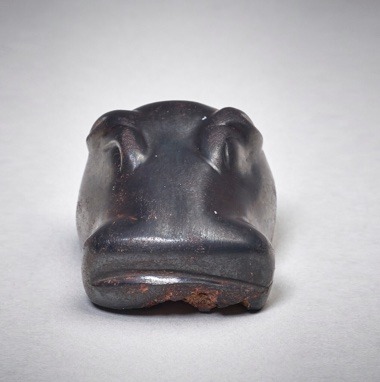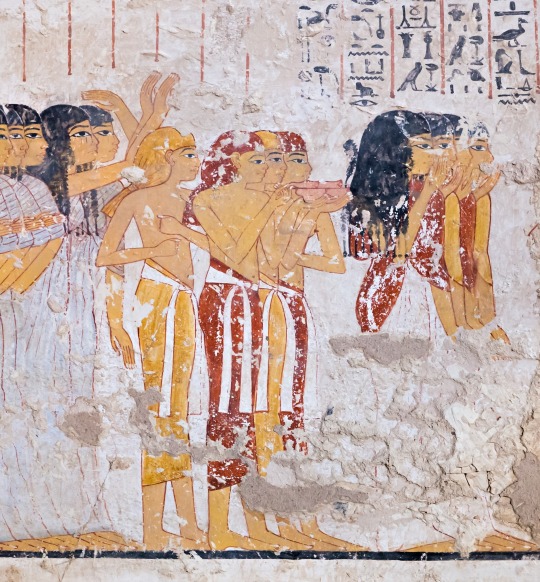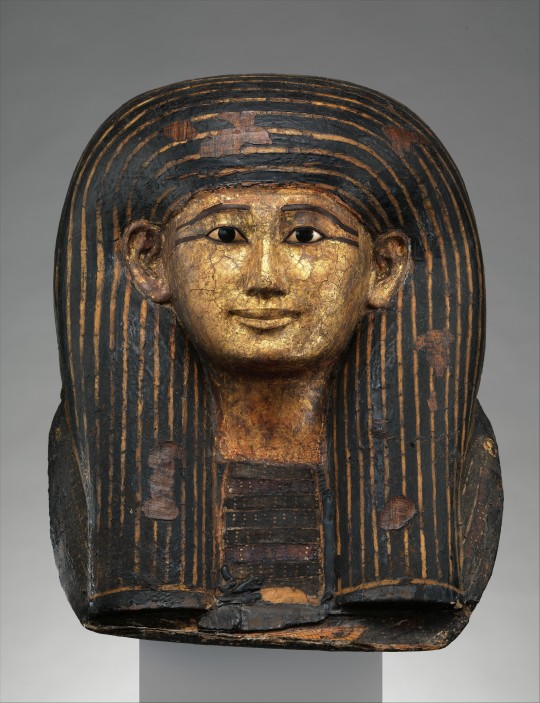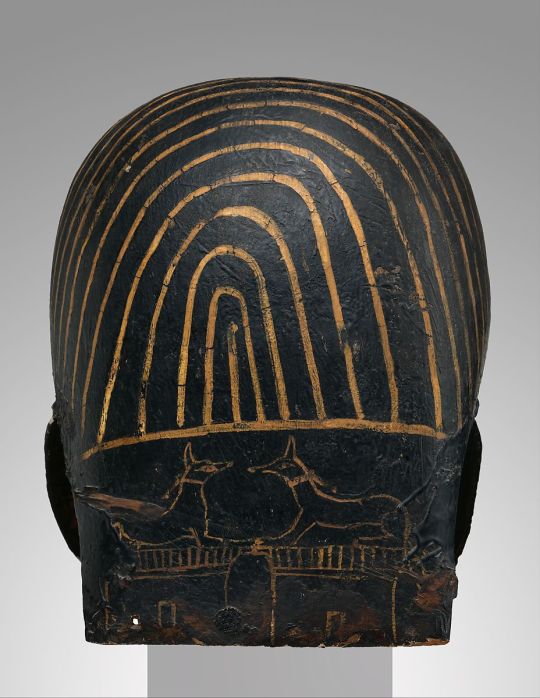#NEW KINGDOM 18TH DYNASTY 1550-1069 B.C.
Photo



AN EGYPTIAN HEMATITE WEIGHT IN THE FORM OF A HIPPOPOTAMUS HEAD
NEW KINGDOM, 18TH DYNASTY, 1550-1069 B.C.
1 1⁄8 in. (2.8 cm.) long.
During the New Kingdom, weights in both stone and bronze often took the form of animals, with the reclining bovine the most popular of all shapes. Weights in the form of hippopotami heads are comparatively rare, with only a handful of examples documented.
#AN EGYPTIAN HEMATITE WEIGHT IN THE FORM OF A HIPPOPOTAMUS HEAD#NEW KINGDOM 18TH DYNASTY 1550-1069 B.C.#archeology#archeolgst#ancient artifacts#history#history news#ancient history#ancient culture#ancient civilizations#ancient egypt#egyptian history
355 notes
·
View notes
Text

Gold Scarab Ring
New Kingdom, 18th to 20th Dynasty, ca. 1550-1069 BC.
Bequest of Eva Catherine Brown.
Now in the Cleveland Museum of Art. 1936.653
Ancient Egyptian turquoise faience scarab (mounted on swivel bezel in modern gold ring). From the end of the third millennium B.C., the scarab beetle served as an amulet in Egypt where it represented the sun god.
The scarab integrated into a gold ring appears in the fourth century B.C. The articulation of the insect and the embellishment of the box reveal craftsmanship of the highest order.
Scarab rings with thicker hoops developed during the Second Intermediate Period. The scarab itself was mounted with a gold wire running through its centre on which it could swivel. As well as gold, silver and electrum were used. They were popular during the New Kingdom period and were worn by both men and women.
Read more
31 notes
·
View notes
Text

Funeral procession of Ramose (Vizier under both Amenhotep III & Akhenaten)
New Kingdom, 18th Dynasty, c. 1550–1069 B.C.
Tomb of Ramose (TT55), Theban Necropolis, Sheikh Abd el-Qurna.
Photograph by manna4u
1 note
·
View note
Text
The Funerary Mask of the Overseeer of Builders Amenhotep



Dynasty: 18th Dynasty
Period: New Kingdom
Date: ca. 1427-1390 B.C.
The Funerary Mask of Amenhotep, The Overseer of the Builders of Amun is a perfect example of the craftsmanship that went into preparing for the afterlife. This Cartonnage mask made of linen, resin, and painted papyrus reflects the many materials used to make Cartonnage masks during the New Kingdom ( ca. 1550-1069 BC). The face gilded with gold and eyes made of alabaster and obsidian is a great reflection that this was someone of high importance and status. In Egyptian society only the elites and people of high rank could afford such luxuries for their own funerary preparations. We know through research and records that the mask originated from a Theban necropolis and is to be dated to around the middle to late years of the Thutmoside period and was acquired by Egyptologist Theodore M. Davis around the late 1880′s.
#Ancient Egypt#ancient world#arthistory#archaeology#anthropology#egyptology#mummification#egyptian archaeology
24 notes
·
View notes
Text
Every traveler has the Pyramids on his bucket list. But I actually found the visit to Luxor more fulfilling than the Giza Pyramids. Don’t get me wrong, the Pyramids are awesome for its sheer scale of human achievement, but that also shows what Luxor has to offer that can beat the Pyramids at its own game.
Luxor is and should be an unmissable part of anyone’s visit to Egypt. From the cursed tomb of Tutankhamun, in the dramatic Valley of the Kings at Thebes, which is a must for all intrepid travellers. Luxor is also home to the biggest temple in Egypt, the vast Karnak Temple complex that holds the Great Temple within its walls all adjacent to a bustling city souk.
The highlight of our trip was over the ruins of Thebes in a hot-air balloon. Another one was a trip down the Nile in a hired felucca for a river-view of Luxor and the ancient ruins. And if you want a taste of “real” Egyptian life sneak off into one of Luxor’s souks – try to get away from the touristy areas and lose yourself in the bustle, odors, and colors of Egyptian street life.
The must-see list that you see as you scroll down is populated by such masterpieces that even having one in your city would feel like a dream. And that would surely spike up your city’s tourist census:) But we can only dream of such monuments. The Egyptians are blessed with an abundance of such wonders.
1. Queens Temple of Hatshepsut: Hatshepsut was the daughter of Thutmose I (1520-1492 BCE) by his Great Wife Ahmose. Thutmose I also fathered Thutmose II (1492-1479 BCE) by his secondary wife Mutnofret. In keeping with Egyptian royal tradition, Thutmose II was married to Hatshepsut at some point before she was 20 years old. During this same time, Hatshepsut was elevated to the position of God’s Wife of Amun, the highest honor a woman could attain in Egypt after the position of queen and one which would become increasingly political and important. She commissioned her mortuary temple at some point soon after coming to power in 1479 BCE and had it designed to tell the story of her life and reign and surpass any other in elegance and grandeur. The temple was designed by Hatshepsut’s steward and confidante Senenmut, who was also tutor to Neferu-Ra and, possibly, Hatshepsut’s lover. Senenmut modeled it carefully on that of Mentuhotep II but took every aspect of the earlier building and made it larger, longer, and more elaborate. Mentuhotep II’s temple featured a large stone ramp from the first courtyard to the second level; Hatshepsut’s second level was reached by a much longer and even more elaborate ramp one reached by passing through lush gardens and an elaborate entrance pylon flanked by towering obelisks. All said and read, this should be the first on your long list in Luxor!
2. Valley of the Kings: The west bank of Luxor had been the site of royal burials since around 2100 BC, but it was the pharaohs of the New Kingdom period (1550–1069 BC) who chose this isolated valley dominated by the pyramid-shaped mountain peak of Al Qurn (The Horn). Once called the Great Necropolis of Millions of Years of Pharaoh, or the Place of Truth, the Valley of the Kings has 63 magnificent royal tombs.
The tombs have suffered greatly from treasure hunters, floods and, in recent years, mass tourism: carbon dioxide, friction and the humidity produced by the average 2.8g of sweat left by each visitor have affected the reliefs and the stability of paintings that were made on plaster laid over limestone. The Department of Antiquities has installed dehumidifiers and glass screens in the worst-affected tombs. They have also introduced a rotation system: a limited number of tombs are open to the public at any one time. The entry ticket gains access to three tombs, with extra tickets to see the tombs of Ay, Tutankhamun, Seti I and Ramses VI.
The underground tombs were also well stocked with all the material goods a ruler might need in the next world. Treasures—like the golden masks found with King Tut—are dazzling, but the tombs also contained the more mundane. Photography inside the tombs is strictly forbidden!
3. Karnak Temple: The Karnak Temple is a massive temple complex to which dozens of pharaohs added their own constructions. The area was in constant development and use between the Middle Kingdom (2080–1640 B.C.) and the early Christian period. The immense size of the complex, as well as its various architectural, artistic, and linguistic details, make it an invaluable historical site and resource for understanding the evolution of ancient Egypt, and thus its conservation is critical. Because of its long history of construction and functionality, the gods worshipped at Karnak range from some of the earliest Egyptian deities to some of the latest, thus offering an impressive presentation of ancient Egyptian religious practices and beliefs. Go at the sunset with the orange hue. It’s truly dazzling. Read more here..
4. Luxor Temple: The temple of Luxor is situated on the east bank of the River Nile in the town of Luxor (Thebes). The temple is dedicated to Amun, Mut, and Khonsu and was the focus of one of the most important religious festivals in ancient Egypt – the annual Opet Festival. During this festival the cult statues of Amun, Mut and Khonsu would travel from Karnak to Luxor. As a result, the temple is not aligned to the river (as is more usual) but to the temple complex at Karnak. It is also proposed by some that the temple was in fact dedicated to the royal ka, which was symbolically joined to the living king during the Opet festival. Thus the Luxor Temple was a shrine of the king’s cult and not just to the Theban god Amun and his family. The original part of the Temple of Luxor consisted of a large peristyle court and a complex of halls and chambers beyond. In one hall is a granite shrine of Alexander the Great.
5. Luxor Museum: This wonderful museum has a well-chosen and brilliantly displayed and explained collection of antiquities dating from the end of the Old Kingdom right through to the Mamluk period, mostly gathered from the Theban temples and necropolis. The ticket price puts off many, but don’t let that stop you: this is one of the most rewarding sights in Luxor and one of the best museums in Egypt.
Among the items on display are grave goods from the tomb of the 18th dynasty pharaoh Tutankhamun and a collection of 26 New Kingdom statues that were found buried in the Luxor statue cache in the nearby Luxor Temple in 1989. The royal mummies of two pharaohs – Ahmose I and Ramesses I – were also put on display in the Luxor Museum in March 2004, as part of the new extension to the museum, which includes a small visitor centre. A major exhibit is a reconstruction of one of the walls of Akhenaten’s temple at Karnak. One of the featured items in the collection is a calcite double statue of the crocodile god Sobek and the 18th Dynasty pharaoh Amenhotep III.
6. Valley of the Queens: The tombs in the Valley of the Queens mostly belong to the 19th and 20th dynasties. A total of almost 80 tombs are now known, most of them excavated by an Italian expedition led by E. Schiaparelli between 1903 and 1905. Many of the tombs are unfinished and without decoration, resembling mere caves in the rocks. There are few incised inscriptions or reliefs, with much of the decoration consisting of paintings on stucco. Unfortunately, most of the tombs are closed to the public at the moment. The Valley of the Queens is most famous for the Tomb of Queen Nefertari, which has been closed for several years because of preservation issues. The best open tombs in the area are the Tomb of Prince Amen-her-khopshef, a son of Ramses III, which contains well-preserved colors on its wall paintings, and the Tomb of Titi.
7. Hot air Balloon ride over the open air museum and the Nile: Every morning the sky ovre the Nile and the valleys gets full of hot-air balloons (it’s a long-established tradition for visitors to drift over the Nile in a balloon). Known as one of the most popular places in the world for balloon rides, attracting enthusiasts and travellers year round for the experience, Luxor features spectacular surrealistic landscapes and breath-taking views, making it a dream destination for photographers. Where else can you get panoramic views of the valleys with the huge entrances and pillars on one side and the meandering Nile o the other with teh sun reflecting off of it!
Though its listed a number 7, this was our most favourite exerience in Luxor!
8. Tombs of the Nobles: If you haven’t had your fill of tombs in the Valley of the Kings then make a beeline for the Tombs of the Nobles, which may be less famed, but actually include much better-preserved examples of tomb paintings. The site contains around 400 tombs of various dignitaries that date roughly from the 6th dynasty right up to the Ptolemaic era. The tomb paintings here aren’t so concerned with guiding the dead into the afterlife; instead, they showcase scenes from Egyptian daily life. In particular, the Tomb of Khonsu, Tomb of Benia, Tomb of Menna, and Tomb of Nakht are home to some of Egypt’s most vivid and lively tomb paintings.
Of all the tombs here, the Tomb of Nakht (an official and priest of Amun in the 18th dynasty) is the one to choose if you’re short of time. Only the first chamber has paintings but all are excellently preserved. Abydos has a special place in the sacred landscape of ancient Egypt, as it was believed to be the place where Osiris was buried. Thus, Abydos was an important cult centre for Osiris. A number of temples dedicated to Osiris, all of which were located in one area, were built prior to the reign of Seti. The Temple of Seti, however, was built on new ground to the south of the said temples. Seti’s temple was built mainly of limestone, though parts of it were built in sandstone. Although work began under Seti, the temple was only completed during the reign of his son, Ramesses II. This is visible in some of the temple’s reliefs depicting Ramesses slaying Asiatics and worshipping Osiris
9. Mortuary Temple of Seti: Abydos has a special place in the sacred landscape of ancient Egypt, as it was believed to be the place where Osiris was buried. Thus, Abydos was an important cult centre for Osiris. A number of temples dedicated to Osiris, all of which were located in one area, were built prior to the reign of Seti. The Temple of Seti, however, was built on new ground to the south of the said temples. Seti’s temple was built mainly of limestone, though parts of it were built in sandstone. Although work began under Seti, the temple was only completed during the reign of his son, Ramesses II. This is visible in some of the temple’s reliefs depicting Ramesses slaying Asiatics and worshipping Osiris. Its a perfect day trip from Luxor.
Practical Tips and info:
Pack light cottons for the day. A woolly or fleece for the evening if you are in Luxor between November and March
It can get hot all year round. Dehydration is a health risk. Always carry plenty of water.
Start getting out of the hotels early to avoid the crowds and the sun
Baksheesh(tips) and self declared guides are an ever present irritance all over Luxor, just like Giza.
Bargaining is a way of life here.
Do try ‘Karkade’ juice thats made from dried hibiscus flowers. Its very cooling and avaialble in many places. Do take the dried flowers home. They make a good souvenir, one that you can drink and alos make cocktails with!
Beware of over-tipping! Touts in Luxor have an extremely effective communication network. If you become known as a generous tipper, you will receive ever more attention
You can purchase a “Luxor Pass” valid for 5 days from an office near Luxor Museum or from Luxor Public Library. Its well worth it if you intend to visit more than three sites.
Students with ISIC cards get a huge discounts on entry tickets.
Enquire around before booking hot air balloon rides. We had in our group who paid for the same ride anywhere from 30 to 100USD. All of us were in teh same basket no less!
There are many good resorts and hotels here. We stayed at Maritim Jolie Ville Kings Island. Its actually an island in the Nile. How cool is that? Every evening you can catch a boat ride form their jetty after a hard day of walking. It surely was one of the best ones I had been to, ever!
Indians and most nationals need a pre approved visa to get to Egypt (Embassy website)
What I Read: This gem of a book takes you deeper into the myths and customs of the ancient Egypt. All the while giving a different persepctives into the detail and scale of things in Luxor. Well worth a read. (Amazon link)
What I Saw: The Spy Who Loved Me was shot a bit in the Karnak temple. Do also watch ‘Valley of the Kings’ that was extensively shot here.
Luxor: Valleys, Hot air Balloons & the Nile Every traveler has the Pyramids on his bucket list. But I actually found the visit to Luxor more fulfilling than the Giza Pyramids.
0 notes